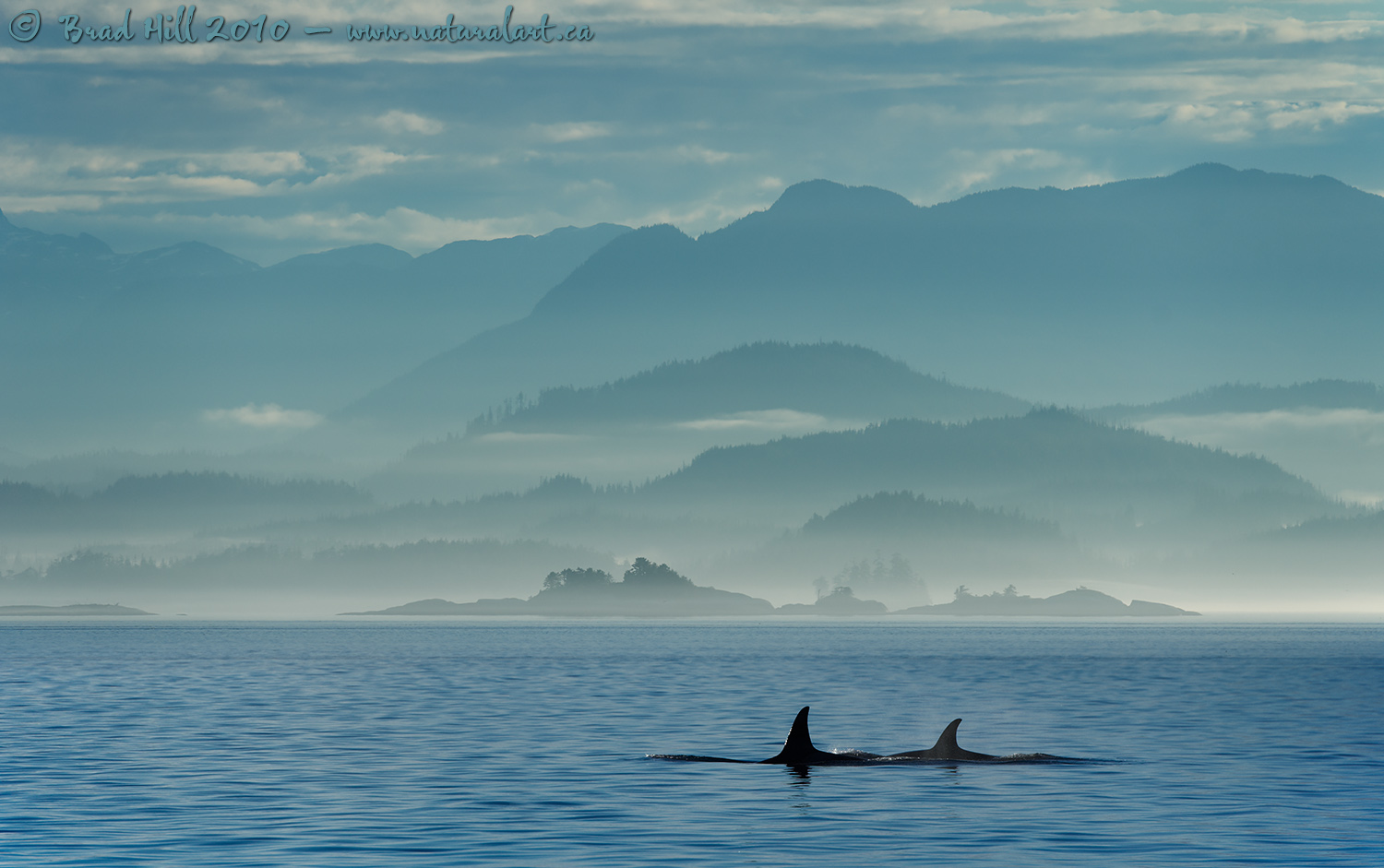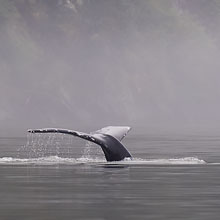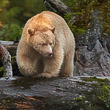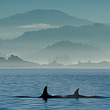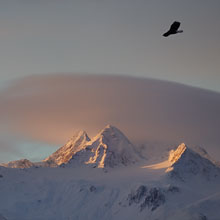Availability: Limited Edition Print - info coming soon!
In the Field
Misty Morning Cruise. Johnstone Strait Region (northern Vancouver Island), BC, Canada. August 25, 2010.
I captured this animalscape* (Orcascape??) during my first of many trips to the Johnstone Strait region near the northern tip of Vancouver Island. The region is known for its biological richness, which partly manifests itself in the form of a large number of resident Orcas (aka Killer Whales) and other aquatic mammals (including Humpback Whales, Gray Whales, various dolphin and porpoise species, sea otters, and both Steller Sea Lions and Harbor Seals). The Orcas are, more or less, "emblematic" of the region and I hoped to create at least one image that captured what I considered to be the "essence" of the region. I think this may be that image.
Technically this was a real tough image to capture (and process, for that matter) - there were a lot of constraints/hurdles to overcome. And, of course, there was a lot of luck involved. The biggest lucky break came with the presentation of this great scene to me - the wonderful lighting and mist were a godsend, and then to have the two Orcas swimming by...well...yes, sometimes I DO have horseshoes up my ____! Thank you Photeus! But what's that old saying? Oh yeah..."f8 and be there!" - you ain't about to see stuff like this sitting at home in an armchair! ;-)
But I will take credit for a few decisions leading to the production of this image. First...that background was WAY in the distance - and I wanted those ridges to be a dominant part of my composition. Plus, I wanted the distance between the whales and the ridges compressed and more or less "stacked up". So...I needed to use a relatively long lens to produce the image I wanted. To completely freeze the movement of the Orcas I needed quite a fast shutter speed - somewhere in the range of 1/1000s or higher. The obvious first thought is to open up the aperture to get the speed you need to freeze the action (after all, I was shooting with a f2.8 400mm lens). However, if I did this and focused on the Orcas I wouldn't have had the depth of field to render the background sharply (which is something I felt was important in making the shot work). Hmmm. One potential solution would be to crank the ISO WAY up so I could both stop down (to maybe f11 or smaller) and still shoot at a high shutter speed. Good idea in theory, but my own past experience with my D700 has taught me that these kind of mid-tone dominated scenes can really show noise at moderate to high ISO's (and I would have needed ISO 1600 or higher to get the DOF and shutter speed I needed) so I discarded the concept of cranking up the ISO (and I honestly doubt I could have found the DOF I needed anyway).
So...on to plan B. Instead of trying to push the laws of optics in a single image, I decided that the only way to get the shot I wanted was to capture two images - each focused on a different part of the scene - and then merge the two images in Photoshop. So...I waited until the Orcas were exactly where I wanted in the scene and shot a burst of images as they surfaced, then (without moving the camera), I toggled my focus bracket higher in the frame, re-focused on the ridges, and shot another quick burst of images. Then, to make a long story short, I merged the best images from each burst into a single image using Photoshop CS5. So what you're looking at here is actually what I call a "focal plane composite" of two shots of the same scene.
Which leads to an interesting question: Is this type of image creation "ethical"? There's no doubt that this is "slippery slope" issue that's dominated by shades of grey. But it's my view that image "corrections" made to compensate for the limitations of our cameras and/or lenses (and I know of few who would argue that our eye sees the world with the shallow depth of field that a super-telephoto lens does when shot wide open) are completely legitimate. In this case I used modern technology to increase the depth of field of an image that I THINK more closely replicates the scene I observed in the field. And I have a hard time accepting this is wrong. But, whenever I perform such a correction, I do feel compelled to openly disclose how the image was created. Then at least you can be the judge!
Like most animalscapes, this image is best appreciated when see LARGE! So here's a 2400 pixel version of it:
• Misty Morning Cruise: Download 2400 pixel image (JPEG: 1.0 MB)
ADDITIONAL NOTES:
1. This image - in all resolutions - is protected by copyright. I'm fine with personal uses of it (including use as desktop backgrounds or screensavers on your own computer), but unauthorized commercial use of the image is prohibited by law. Thanks in advance for respecting my copyright!
2. Like all wildlife photographs on this website, this image was captured following the strict ethical guidelines described in The Wildlife FIRST! Principles of Photographer Conduct. I encourage all wildlife photographers to always put the welfare of their subjects above the value of their photographs.
3. This image was captured during my "Humpback, Orcas, Sea Lions & More" photo tour in August of 2010. Each year I offer trips into two different parts of the Great Bear Rainforest as well as one to photograph aquatic mammals and oceanscapes near the northern tip of Vancouver Island. And, in selected years, I also offer photo tours to locations to capture other highly sought-after subjects, such as various owl species of the boreal forest and wildlife of Canada's Arctic. Details about these trips can be found on the Photo Tours page of this website.
*4. For a more detailed discussion of the image types I call animalscapes and enviroscapes (and the subtle distinctions between them), just go here...
Behind the Camera
Misty Morning Cruise. Johnstone Strait Region (northern Vancouver Island), BC, Canada. August 25, 2010.
Digital Capture; RAW 14-bit format; ISO 200.
Nikon D700 with Nikkor 400mm f2.8 VRII lens - handheld from sailboat. VR on and set to "Normal" mode.
1/1600s @ f5; -0.33 stop compensation from matrix-metered exposure setting of camera (same exposure setting for both images used to produce this composite image). Two separate images captured - first image focused on Orcas in foreground; second image focused on background ridges.
At the Computer
Misty Morning Cruise. Johnstone Strait Region (northern Vancouver Island), BC, Canada. August 25, 2010.
RAW Conversion to 16-bit TIFF, including first-pass/capture sharpening using Phase One's Capture One Pro 5. Single raw conversion for each of two images used to produce composite image: -0.5 stop exposure compensation applied to each image.
Further digital corrections on 16-bit TIFF file using Adobe's Photoshop CS5 and Light Craft's LightZone. Photoshop adjustments included compositing and masking of 2 versions of the image, selective saturation of colours, selective curves adjustment, and selective sharpening for web output. Final tonemapping and tweaking performed with LightZone use the (tonemapper/re-light tool).
Conservation
Misty Morning Cruise. Johnstone Strait Region (northern Vancouver Island), BC, Canada. August 25, 2010.
Species Status in Canada*: Endangered - Northeast Pacific southern resident population; Threatened - Northeast Pacific transient population and the Northeast Pacific northern resident population; Special Concern - Northeast Pacific offshore population.
Killer Whales (Orcinus orca) have an extremely high profile in modern pop culture and have become the "poster child" of a number of conservation groups. In most areas where Killer Whales are found they show a remarkable ability to adapt to a variety of habitats - they are found in all oceans, in water ranging in temperature from below 0 Celsius to almost hot tropical waters, and will occasionally even spend significant amounts of time in brackish water or even rivers.
Because the population sizes of Killer Whales are very low and because they have a very low reproductive rate, they face immediate risk from human-related environmental disturbances, including the immunotoxic effects of toxic chemicals we pour into the oceans and to reduction in prey availability (such as salmon).
For more information on the status of Killer Whales in Canada, go to: http://www.speciesatrisk.gc.ca and search under "Killer Whale".
*as determined by COSEWIC: The Committee on the Status of Endangered Wildlife in Canada













